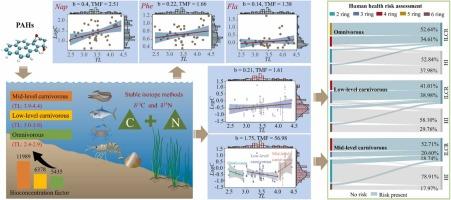多环芳烃在海洋食物网中的生物累积和对人类健康的潜在风险:营养转移视角
IF 12.2
1区 环境科学与生态学
Q1 ENGINEERING, ENVIRONMENTAL
引用次数: 0
摘要
多环芳烃(PAHs)是水生环境中的持久性污染物,可在海洋生物中积累,并通过食物网中的营养转移对人类构成潜在的健康风险。然而,在不同营养水平的生物体中,多环芳烃的积累和健康风险尚不清楚。研究了北部湾40种海洋生物体内多环芳烃的积累和营养转移,并对其健康风险进行了评价。利用稳定同位素方法构建的营养谱,将这些生物划分为3个营养等级:杂食性(15.00%)、低级肉食性(67.50%)和中级肉食性(17.50%)。这些生物中总多环芳烃的污染水平从“轻度污染”到“中度污染”不等,所有生物都表现出显著的多环芳烃积累(生物浓度因子值>;2000)。多环芳烃总浓度随营养水平的增加而增加,与中层食肉动物的趋势一致;低级食肉动物杂食动物。值得注意的是,只有三种多环芳烃化合物(Nap, Fla和Phe)表现出生物放大效应,而其他化合物表现出营养稀释效应。致癌风险评估显示,所有人群的致癌风险都处于“不可接受的”水平,食用中等水平的肉食性食品风险最高。这些发现从营养转移的角度为多环芳烃的积累和健康风险提供了新的见解。本文章由计算机程序翻译,如有差异,请以英文原文为准。

Bioaccumulation and potential human health risks of PAHs in marine food webs: A trophic transfer perspective
Polycyclic aromatic hydrocarbons (PAHs) are persistent pollutants in aquatic environments that can accumulate in marine organisms and pose potential health risks to humans through trophic transfer in the food webs. However, the accumulation and health risks of PAHs in organisms at different trophic levels remain unclear. This study investigated the accumulation and trophic transfer of PAHs in 40 marine organisms from Beibu Gulf (China), and assessed their health risks. Utilizing the trophic level spectrum constructed with stable isotope methods, the organisms were categorized into three trophic levels: Omnivorous (15.00%), low-level carnivorous (67.50%), and mid-level carnivorous (17.50%). The contamination levels of total PAHs in these organisms ranged from "mild pollution" to "moderate pollution", with all organisms exhibiting significant PAH accumulation (Bioconcentration factor value > 2000). Total PAH concentrations increased with higher trophic levels, following the trend of mid-level carnivores > low-level carnivores > omnivores. Notably, only three PAH compounds (Nap, Fla and Phe) showed biomagnification effects, while the others exhibited trophic dilution. Carcinogenic risk assessment indicated an “Unacceptable risk” level for all populations, with the highest risk due to consumption of mid-level carnivorous. These findings offer new insights into the accumulation and health risks of PAHs from a trophic transfer perspective.
求助全文
通过发布文献求助,成功后即可免费获取论文全文。
去求助
来源期刊

Journal of Hazardous Materials
工程技术-工程:环境
CiteScore
25.40
自引率
5.90%
发文量
3059
审稿时长
58 days
期刊介绍:
The Journal of Hazardous Materials serves as a global platform for promoting cutting-edge research in the field of Environmental Science and Engineering. Our publication features a wide range of articles, including full-length research papers, review articles, and perspectives, with the aim of enhancing our understanding of the dangers and risks associated with various materials concerning public health and the environment. It is important to note that the term "environmental contaminants" refers specifically to substances that pose hazardous effects through contamination, while excluding those that do not have such impacts on the environment or human health. Moreover, we emphasize the distinction between wastes and hazardous materials in order to provide further clarity on the scope of the journal. We have a keen interest in exploring specific compounds and microbial agents that have adverse effects on the environment.
 求助内容:
求助内容: 应助结果提醒方式:
应助结果提醒方式:


